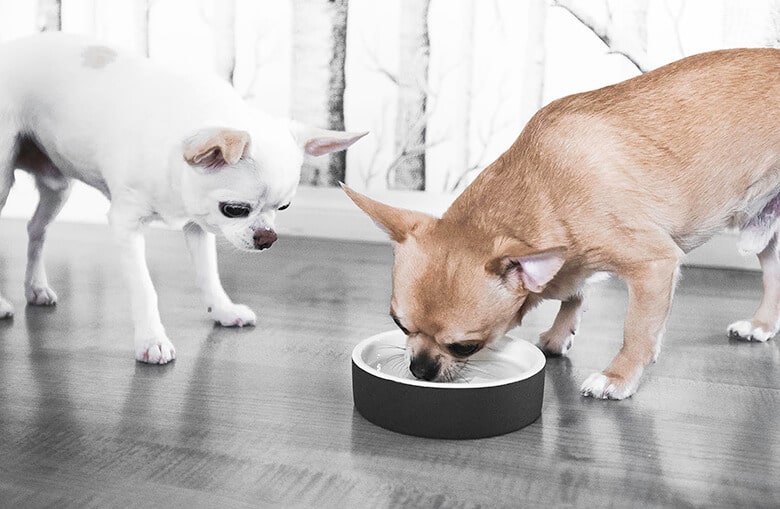As a responsible pet owner, ensuring the well-being of your dog is paramount. One common scenario faced by dog owners is encountering shared water bowls in public spaces. The question arises: can dogs safely drink from these communal water sources? While it may seem harmless and convenient, there are potential health risks associated with allowing your dog to drink from shared water bowls. Understanding these risks is crucial for making informed decisions about your dog’s hydration needs.
Can Dogs Share Water Bowls?
When it comes to dogs using shared water bowls, the answer isn’t straightforward. While dogs need access to water, several factors must be considered before allowing them to drink from shared water bowls. These factors include the environment around the shared water bowl and the condition of the bowl itself.

Contamination
Shared water bowls, especially those found in public places like dog parks, outdoor events, and outside restaurants and shops, carry a certain level of risk for dogs. These bowls may become contaminated with various pathogens, posing a potential threat to your dog’s health. Even within the same home, if one dog is carrying an illness, sharing a water bowl could potentially spread the infection to other dogs.
To illustrate the potential risks, consider the presence of bacteria such as Leptospira, which can cause leptospirosis in dogs. This bacterium can survive in water and moist environments for prolonged periods, making shared water bowls a potential source of transmission.
Furthermore, parasites like Giardia and Cryptosporidium can also be present in shared water bowls, leading to gastrointestinal issues in dogs. Understanding these risks highlights the importance of being cautious when allowing your dog to drink from communal water sources.
Hygiene
Maintaining proper hygiene around shared water bowls is challenging, especially in high-traffic areas or locations with multiple dogs. Even with regular cleaning, it’s difficult to ensure that these bowls remain free from harmful pathogens. Factors such as saliva, dirt, and other contaminants introduced by different dogs further contribute to the challenge of maintaining hygienic conditions.
Additionally, the material of the water bowl itself can harbor bacteria if not cleaned thoroughly and regularly. Porous materials, such as plastic, can retain bacteria even after cleaning, increasing the risk of contamination.
Behavioral Concerns
Beyond the health risks, allowing your dog to drink from shared water bowls can lead to behavioral concerns. In a busy environment with multiple dogs, competition for access to the water bowl may arise, potentially causing stress or conflict among the animals. This can lead to aggressive behavior or anxiety, negatively impacting your dog’s overall well-being.
Risks of Public Water Bowls
Public water bowls pose specific risks due to the unpredictable nature of the environments in which they are placed. Understanding these risks is essential for making informed decisions when providing water for your dog in public spaces.
Unpredictable Contaminants
In public settings, shared water bowls are exposed to a wide range of contaminants, including bacteria, viruses, and parasites. Dogs visiting these areas may have varying health statuses, potentially introducing new pathogens into the water bowl. This unpredictability increases the likelihood of exposure to harmful microorganisms, making shared water bowls a potential source of infection for your dog.
Lack of Oversight
Public water bowls often lack consistent oversight and maintenance. While some establishments may make efforts to keep these bowls clean, the sheer volume of dogs accessing them in high-traffic areas makes it challenging to maintain a consistently safe and hygienic environment. Without regular monitoring and cleaning, these communal water sources can become breeding grounds for harmful pathogens.
Environmental Factors
Environmental factors, such as temperature and sunlight exposure, can further exacerbate the risks associated with public water bowls. Stagnant water in these bowls, combined with warm temperatures, creates an ideal breeding ground for bacteria. Additionally, exposure to direct sunlight can promote the growth of algae, which poses additional health risks to dogs.
| Potential Pathogens Found in Public Water Bowls |
|---|
| – Leptospira (causing leptospirosis) |
| – Giardia and Cryptosporidium (parasites) |
| – Various bacteria and viruses |
Can Dogs in the Same Home Share Water Bowls?
Even within the same household, the practice of allowing dogs to share water bowls carries potential risks. While it may seem harmless to let your dogs drink from the same bowl, this behavior can lead to the spread of illnesses and infections, particularly if one dog is unwell.
Household Health Risks
Sharing water bowls among dogs in the same home can facilitate the transmission of diseases and parasites. For example, if one dog contracts a bacterial infection or picks up parasites from an outdoor environment, sharing a water bowl can lead to the spread of these pathogens to other dogs in the household.
Behavioral Dynamics
In multi-dog households, sharing a water bowl can also impact the dynamics between the dogs. Dominance-related conflicts may arise, leading to tension during water consumption. Additionally, dogs with varying energy levels or health conditions may require different levels of hydration, making it challenging to ensure equitable access to water when sharing a single bowl.
Preventive Measures
To mitigate the risks associated with shared water bowls in multi-dog households, it’s advisable to provide separate water bowls for each dog. This approach helps minimize the potential for disease transmission and reduces the likelihood of behavioral conflicts during water consumption.
How To Safely Provide Water for Your Dog
Given the potential risks associated with shared water bowls, it’s important to consider alternative methods for providing water to your dog, both at home and in public settings.

Portable Water Containers
Carrying a portable water container when taking your dog out ensures that you can provide clean, uncontaminated water for your pet. This approach minimizes the reliance on shared water sources and allows you to maintain control over the quality and cleanliness of the water provided to your dog.
Disposable Water Bowls
Disposable water bowls offer a convenient solution for providing water to your dog in public spaces. These single-use bowls reduce the risk of contamination and eliminate the need for carrying bulky containers. Once your dog has finished drinking, the disposable bowl can be discarded, ensuring that your pet does not come into contact with potentially contaminated surfaces.
Regular Cleaning and Maintenance
For households with multiple dogs, maintaining separate water bowls for each pet is crucial. Regular cleaning and disinfection of these bowls help minimize the risk of disease transmission and ensure that each dog has access to clean water. Using non-porous materials for water bowls, such as stainless steel or ceramic, can also aid in preventing bacterial retention.
Conclusion
While the sight of a communal water bowl may seem like a welcome convenience for your thirsty pup, it’s important to recognize the potential health hazards associated with shared water sources. Whether in public spaces or within the same household, the risks of contamination, hygiene concerns, and behavioral dynamics underscore the importance of carefully managing your dog’s access to water. By understanding these risks and implementing preventive measures, you can prioritize your dog’s health and well-being while ensuring they have access to clean and safe drinking water. Taking proactive steps to provide water for your dog, whether through portable containers, disposable bowls, or individual water bowls at home, helps safeguard your pet against potential health threats associated with shared water sources.

